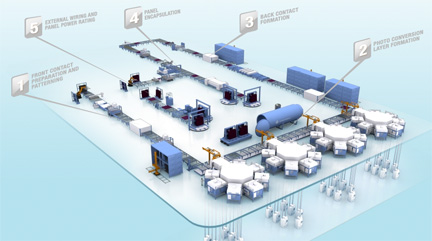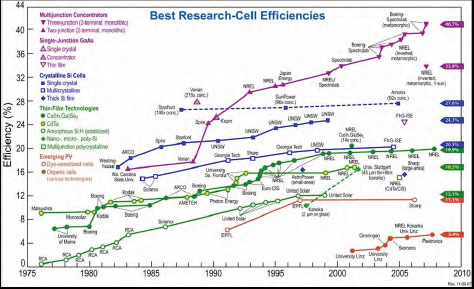Wednesday, July 21st, 2010
After at least a year of being in denial, Applied Materials (AMAT) finally acknowledged some of the reality that there is no market for 6% efficient photovoltaic (PV) fab lines, and killed the “SunFab” that has been sold to unfortunates over the last few years. With no new customers expected, and old customers going bankrupt or having to retool lines to stay running, these thin-film amorphous-silicon (TF a-Si) on glass turnkey production lines are clearly not capable of keeping up with 20% efficient crystalline-silicon (c-Si) and 10% efficient TF technologies. However, the company CEO refuses to acknowledge any mistakes, says they’ll fill the backlog, and claims that, “competitive pressures from crystalline silicon…did not allow the market to take off.” First Solar shipped ~1GW of ~10% efficient TF PV in 2009. The market took off, just not with SunFabs.
AMAT chairman of the board of directors, president, and CEO Mike Splinter further asserted that, “SunFab is a remarkable product. Unlike anything we have done before, it is an example of the kind of revolutionary innovation that Applied Materials is capable of producing. In just a few years we developed a turnkey solution, successfully executed our technology roadmap, achieving greater than 10% stabilized module efficiency and silicon uniformity across the 5.7 square-meter substrate.”
The above quote—part of Splinter’s online video non-acceptance of responsibility—is an amazing example of corporate double-speak, in that each sentence is factually correct while evading key facts. In recent months the world has seen the CEOs of BP, Toyota, and Apple issue various official statements to deal with problems; evasive corporate positioning statements never help in the end.
Let’s examine Splinter’s evasions in some detail:
-
Quickly developed a turnkey solution – by cobbling together old in-house FPD tools with pricey technology acquisitions the company did offer a turnkey line (figure)…where just the tool depreciation costs alone could be estimated to add $0.60/W to manufacturing cost (see below).
-
Successfully executed the technology roadmap – while utterly failing to execute on a business roadmap that could provide competitive products to the market.
-
Achieved >10% stabilized module efficiency – sure, downhill with the wind on a good day in the lab at extra cost for dual- and tri-layer materials stacks…while routine cost-effective fab results remained at 6% for a single layer.
AMAT will, of course, continue to try to sell over-priced support services to the unfortunates who bought SunFabs, so some of the people who had been working in the PV division will be moved over to the “Repairs & Spares” division. The company’s Xi’an, China PV R&D center will cease working on TF technology and will focus on mc-Si and c-Si wafers instead. The c-Si PV tools sold by AMAT—essentially all of which were acquired over the last four years—continue to do well in the market. Still, the company will likely lose hundreds of employees and will write-off ~$400M. Mark Pinto will remain in charge of PV products as executive vice president and general manager of the Energy and Environmental Solution (ESS) group, while also remaining as CTO of AMAT Corp.
In the video Splinter said, “Innovation is the heart of our company. We’ll take the lessons from SunFab and use them to make us stronger.”
What lessons might we learn from SunFab?
-
If you supply technology, don’t bet the company against innovation. When AMAT launched SunFab it was a bet that innovation in thin-film PV would not succeed. Choosing 6% efficient and mature a-Si technology in 2006 was a bet against less-mature CdTe and CIGS thin-film technologies (had First Solar failed to develop $1/Wp with 10% efficient CdTe then things might be different for a-Si in 2010).
-
If you buy technology, don’t bet the company against innovation. After betting the company on a SunFab line, Sunfilm AG in Grossroehrsdorf, Germany filed for bankruptcy protection on March 26 of this year. After buying a standard (40MW/year @ 6% efficiency) SunFab, Moser Baer in Greater Noida, India (also with 80MW/year c-Si cell/module fab capacity) had to idle the TF line for much of 2009 while working to customize it such that it could deliver ~7% efficiency. Signet Solar in Dresden, German used over a year of depreciation of a SunFab line to deliver a grand total of 10MW to the field, while it also did it’s own upgrade to ~7% efficiency.
-
Do the math. A basic 40MW/year capacity SunFab line was priced at ~US$120M; assuming 5-year linear depreciation, this results in $0.60/W just to pay for the cost of equipment depreciation! Considering the rule-of-thumb that the module cost is ~60% of the total installation cost, and that total cost scales with the area to be installed, and that First Solar’s ~10% efficient modules set $1/W price-points for TF, it seems that you would have to sell 6% efficient a-Si panels for $0.60/W to try to complete…the same price you pay just to own the tooling! Maybe a vertically integrated company building solar farms like T-Solar can afford to run a SunFab line at a loss, but even they might see reduced farm costs with buying mc-Si or c-Si modules on the open market.
Research efficiencies (figure) are not the same as fab efficiencies, but the more mature the technology the closer fab efficiencies are to their practical limits. When SunFab was conceived, the maximum lab result was 12% for a-Si TF PV, and having already been run in fabs for decades was known to result in ~6% efficiency in production. In contrast, while both CdTe and CIGS had been explored in labs for decades with champion results reaching to 16-18%, fab processes were still relatively immature and could thus be expected to improve significantly over time from ~6%.
The reality of the PV module market is that CdTe and CIGS TF technology suppliers continue to innovate in their fabs, with First Solar leading the way down the $/W learning curve. Fabs still trying to run a-Si at 6-7% efficiency face a serious gap compared to ~10%, and stacking a multi-crystalline (mc-Si) TF over the a-Si to create a more expensive “tandem junction” really only provides 8-9%.
In the analysts’ question-and-answer sessions today, AMAT executives continue to assert that tandem junction TF will win in the market when a-Si fails, so that the company will sell new mc-Si CVD tools to old a-Si SunFab lines eventually. However, if the cost/benefit argument is valid for a-Si/mc-Si TF then why wouldn’t all customers opt for this today?
The only reason AMAT has a story to tell in PV today is because of the acquired portfolio of c-Si OEMs. With SunFab, Splinter effectively bet the company against thin-film innovation. How sad and ironic for a company that was built on thin-film technology innovation (for IC fabs).
There are thousands of hardworking engineers and technicians who’ve lost years of their lives by mistakenly working on SunFab, both within AMAT and at customer sites. Investors into companies buying SunFab lines stand to lose hundred of millions of dollars. The entire PV industry loses credibility when AMAT’s SunFab is added into high profile technology blunders like Nanosolar. What have we learned again? -E.K.
Tags: a-Si, CdTe, CIGS, efficiency, fab, mc-Si, PV, thin-film

